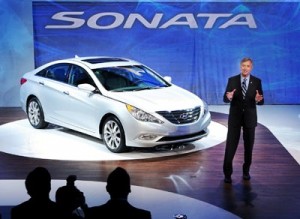You’ll find John Krafcik out running, every morning, before he sits down with the reporters gathering in San Diego for this week’s launch of the all-new, 2011 Hyundai Sonata. “Stay humble, stay hungry,” is a favorite phrase for the lean and trim CEO of the Korean maker’s fast-growing U.S. subsidiary, and it’s one that informs the way he runs both his life and his company.
It wasn’t all that long ago that Hyundai was the butt of jokes for late-night comics, a company struggling to just hang on in the hotly competitive U.S. market. But things have shifted dramatically as the maker has rebuilt its product line and its image, reversing a long-standing reputation for bland design, boring products and questionable quality.
Market share jumped from 3.0% to 4.2% last year – amidst a downturn during which Hyundai was one of only three brands to actually grow volume – but 2010 will be the real test of Hyundai’s turnaround.
(Click Here for the results of a new study revealing Hyundai, Ford making significant gains in share, loyalty and more.)
To get a sense of what Hyundai has in store – and how it will take advantage of opportunities like arch-rival Toyota’s worsening safety scandal – TheDetroitBureau.com spent a morning driving the new 2011 Sonata with Krafcik as co-pilot. Here’s what he had to say:
TheDetroitBureau: While it’s still too early to tell, many analysts believe manufacturers, like Hyundai, could benefit from the worsening safety scandal involving Toyota. Do you agree?
Krafcik: For people considering Hyundai, very frequently, the other car they’re considering is a Toyota…(but) they’re such a well-known, trusted brand that, in the past, we would very frequently lose in that comparison. Now, with the new situation, we are winning 80, 90% of the time.
TDB: Does that mean your special incentive program, directly targeting Toyota owners, is working?
Krafcik: The program isn’t generating much of a response. We are not conquesting (current)Toyota owners right now. They have tended to be among the most loyal in the industry (because) Toyota used to be an easy choice. It wasn’t something you had to explain to your friends and neighbors. But, where it was a default choice, owners now know that other people have heard about the problems Toyota is having and it is going to become more difficult to explain why they stick with the brand. That could be a difficult problem for Toyota, going forward.
TDB: So, how does Hyundai take advantage of the situation?
Krafcik: For Hyundai, it’s (a matter of sticking with) the game plan in place, focusing on QRD — quality, reliability, durability – our 10-year warranty and our new products, all of them confidence builders. But maybe building an emotional connection with buyers becomes more important than ever because it may give the former Toyota buyer more permission than ever to choose us, a nice set of reasons, from rational to emotional, from the brain to the heart.
TDB: Hyundai may be more familiar with Toyota’s problems than most other brands, considering the quality issues you had in years past.
Krafcik: We didn’t have quality figured out when we came to the American market. Because of that, and the near-death experience we had, we have had to over-compensate for quality for the last 15 years and we had to turn that into a competitive advantage. Toyota will do the same thing. They will show the world their quality, safety and critical processes are second-to-none.
TDB: If anything, your surprising turnaround has gotten many potential buyers to give you the benefit of the doubt on new products, like your first luxury car, the Genesis sedan. But eventually, don’t you have to prove you’re not just competitive, but able to lead?
Krafcik: Look at the new Sonata, where we’re aiming for both design and fuel-economy leadership. We needed to make a bold statement: don’t think of Hyundai as bland or derivative anymore. That’s the sort of thing that will take us to the next level.
TDB: A few years ago, barely one in five Americans would seriously consider a Hyundai. Now it’s nearing one in three. But what about the rest?
Krafcik: Frankly, that’s plenty, considering where we need go in next 4 or 5 years. It takes time, but we’ve gone from 20% to 30% in just a few years, and that’s significant. Most companies will do high-fives for picking up a single point.
TDB: With your new American assembly plant, you have lots of opportunities to grow. What’s your goal?
Krafcik: For 2010, we want to exceed the 435,000 (vehicles) we sold last year. We’re not going to see the sort of market share growth we had last year, from 3.0 to 4.2%. A company like ours, the classic strategy is to grow share in a recession, and then pick up volume when the market recovers.”
TDB: You now have nine models. Are more coming?
Krafcik: Equus, (an even more up-market version of Genesis) is right around the corner, and will be our 10th model, then we have the eco-sport coupe, based on the Velociter concept. We’re building these sub-brands, like Genesis. Elantra now has two body styles, but you can look for more in the future; crossover-type vehicles.
TDB: What about more luxury cars – and a separate Genesis brand?
Kraficik: There are some obvious extensions of the rear-wheel-drive platform that we would look at. One is a smaller, rear-drive, four-door sport sedan, Genesis Coupe-sized. Another is a potential crossover with rear-drive. A separate luxury channel is still a possibility. We want to see how far we can go with Equus. But I think it would be challenging.
TDB: What about a pickup?
Krafcik: I’m not a big fan of compact pickups. It’s a very difficult segment. The domestic makers have an extremely strong position with full-size pickups that makes it difficult for anyone to come in with a compact. We never say never, at Hyundai. But maybe it makes more sense as a Kia.
TDB: Sounds like you’re heading towards 15 models.
Krafcik: I’d say 13 is definitely possible by 2015, but not certain. Of course, Toyota has 18.
TDB: So, what’s Hyundai’s biggest challenge?
Krafcik: I sign off all my communications with four words: “Stay humble, stay hungry.” We’ve had a pretty good run, the last few years, and the last thing I want anyone at Hyundai to do, now, is to think we’ve achieved something and can slow down. We keep setting targets we don’t know how we can meet, and staying hungry is a key to achieving them.


